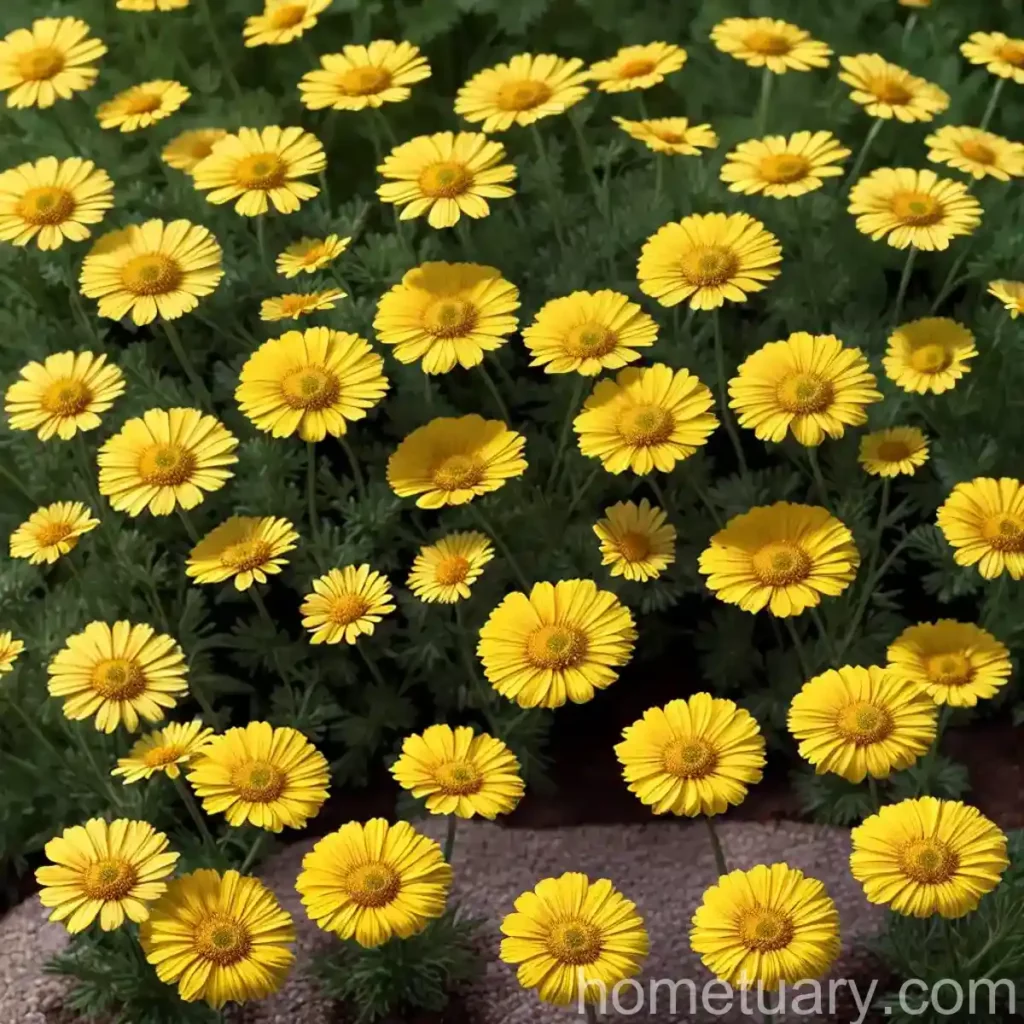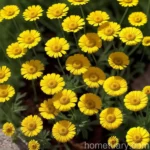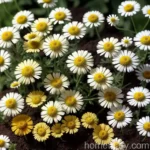Golden Chamomile (Anthemis tinctoria ‘Charme’): A Complete Guide
Golden chamomile, scientifically known as Anthemis tinctoria ‘Charme’, is a delightful herbaceous perennial known for its bright and cheerful daisy-like flowers. In this comprehensive guide, we will delve into the cultivation, uses, and maintenance of this charming plant. Whether you are a gardening enthusiast, a herbalist, or simply someone who appreciates the beauty and benefits of plants, this guide aims to provide valuable insights into the world of golden chamomile.
What is Golden Chamomile?
Golden chamomile, a member of the Asteraceae family, is a herbaceous perennial plant native to Europe and Asia. It is commonly grown for its ornamental value, as well as for its historical medicinal uses. The ‘Charme’ cultivar specifically is known for its vibrant golden-yellow flowers and its compact growth habit, making it a popular choice for gardeners looking to add a splash of color to their landscapes.
Plant Profile
- Common Name: Golden Chamomile
- Scientific Name: Anthemis tinctoria ‘Charme’
- Plant Family: Asteraceae
- Lifespan: Perennial
- Growth Habit: Compact, mound-forming
- Flower Color: Golden-yellow
- Uses: Ornamental, Medicinal
Key Takeaways
Before we delve deeper into the specific aspects of golden chamomile, let’s summarize the key takeaways of this guide:
- Cultivation: Understanding the cultural requirements for successful growth.
- Uses: Exploring the various applications of golden chamomile, including its ornamental value and medicinal properties.
- Maintenance: Learning about the care and maintenance practices to ensure healthy and vigorous growth.
- Common Diseases and Pests: Identifying potential threats to the plant and strategies for disease and pest control.
Now, let’s explore each of these aspects in detail.
Cultivation
Water
Golden chamomile plants typically prefer a moderate amount of water. While they do not thrive in waterlogged conditions, it is essential to keep the soil consistently moist, especially during the active growing season. Adequate moisture is crucial for promoting healthy blooming and overall plant vigor.
Sunlight
In terms of sunlight requirements, golden chamomile thrives in full sun to partial shade. It is crucial to provide the plant with at least 6 hours of direct sunlight daily to ensure robust growth and profuse flowering. However, in regions with particularly hot summers, providing some afternoon shade can be beneficial to prevent scorching.
Fertilizer
When it comes to fertilization, golden chamomile plants have relatively low nutrient requirements. A balanced, all-purpose fertilizer applied in spring as new growth emerges can provide the necessary nutrients for healthy development. Care should be taken to avoid excessive fertilization, as this can lead to excessive foliage at the expense of flowering.
Soil
Golden chamomile thrives in well-draining, loamy soil with a slightly alkaline pH. A rich, fertile soil that retains moisture without becoming waterlogged is ideal for promoting healthy growth and abundant flowering. It is recommended to amend the soil with organic matter, such as compost, to improve its structure and fertility.
Pruning
Pruning is an essential aspect of golden chamomile maintenance, particularly to promote continuous blooming and maintain a compact growth habit. Deadheading spent flowers not only encourages the production of new blooms but also prevents the plant from self-seeding excessively. Additionally, light pruning in late spring can help control the plant’s overall shape and prevent it from becoming leggy.
Propagation
Golden chamomile plants can be propagated through several methods, including division, cuttings, and seed propagation. Here’s a brief overview of each propagation method:
- Division: Divide established clumps in early spring or fall, ensuring that each division has a good root system and several healthy shoots.
- Cuttings: Take softwood cuttings in late spring or early summer, and hardwood cuttings in late summer. Root the cuttings in a well-draining propagation medium with high humidity.
- Seed Propagation: Sow seeds in early spring or fall in a prepared seedbed. Keep the soil consistently moist until germination occurs, typically within 2-3 weeks.
Container Popularity
Golden chamomile is well-suited for container cultivation, making it an excellent choice for balcony gardens, patios, and other small outdoor spaces. When grown in containers, it is important to ensure adequate drainage, as waterlogged soil can be detrimental to the plant’s health. Additionally, regular watering and fertilization are crucial for container-grown specimens, as they have limited access to soil nutrients.
Uses
Ornamental Value
One of the primary uses of golden chamomile is its ornamental value. The ‘Charme’ cultivar, with its vibrant golden-yellow flowers, adds a burst of color to garden borders, rock gardens, and mixed perennial beds. It pairs beautifully with other sun-loving perennials and adds a cheerful and inviting ambiance to the landscape.
Medicinal Properties
Golden chamomile has a long history of medicinal uses, particularly in traditional herbal medicine. The flowers of the plant are rich in essential oils, flavonoids, and other beneficial compounds that are valued for their calming and anti-inflammatory properties. Chamomile tea, prepared from the dried flowers, is a popular herbal remedy for promoting relaxation and alleviating digestive discomfort.
Common Diseases and Pests
Disease Diagnosis
Golden chamomile is relatively resistant to diseases, particularly when grown in favorable cultural conditions. However, excessive moisture can lead to issues such as root rot and powdery mildew. It is important to monitor the plants regularly for any signs of disease, including discolored or decaying foliage, and take appropriate measures to address the issue promptly.
Common Pests
While golden chamomile is generally not heavily targeted by pests, occasional infestations by aphids, spider mites, and caterpillars can occur. Regularly inspecting the plants for signs of pest activity, such as distorted foliage or webbing, can help in early detection and intervention. Natural predators such as ladybugs and lacewings can contribute to pest control in the garden.
Botanist’s Tips
- When selecting a planting site for golden chamomile, consider its preference for well-draining soil and ample sunlight.
- Regular deadheading can significantly prolong the flowering period and maintain a neat and tidy appearance.
- Pruning the plant in late spring can help to rejuvenate its growth and promote a more compact form.
- When using golden chamomile for herbal preparations, harvest the flowers in the morning when their essential oil content is at its highest.
Fun Facts
- In traditional folklore, chamomile was associated with the sun and was often used in rituals and ceremonies to invoke the energy of the sun.
- The name “chamomile” is believed to have roots in multiple languages, including Greek and Latin, and refers to the plant’s apple-like aroma.
- Golden chamomile is not only attractive to humans but also serves as a valuable nectar source for pollinators, including bees and butterflies.
Links to External Resources
To further enrich your knowledge and appreciation of golden chamomile, check out the following external resources:
- The Herb Society – Anthemis tinctoria ‘Charme’
- Royal Horticultural Society – Anthemis tinctoria ‘Charme’
- Missouri Botanical Garden – Anthemis tinctoria ‘Charme’
- Perennial Resource – Golden Marguerite (Anthemis tinctoria)
- North Carolina State University Extension – Anthemis
In conclusion, golden chamomile, with its vibrant blooms and historical significance, is a plant that holds both aesthetic and therapeutic value. By understanding its cultural requirements, uses, and maintenance practices, you can cultivate and appreciate this charming plant in your own garden or landscape. Whether you are drawn to its cheerful flowers, its aromatic properties, or its ecological contributions, golden chamomile is a delightful addition to any natural setting.
Remember to explore the external resources provided to gain further insights into the world of golden chamomile. Cultivate, observe, and savor the beauty and benefits of this remarkable plant, and let it bring joy and wellness to your surroundings.















